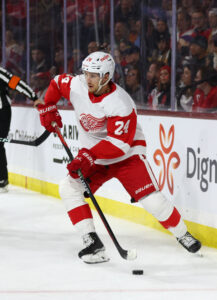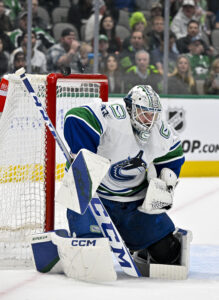The Vancouver Canucks are back to square one, once again questioning whether their depth is strong enough to earn a spot in the playoffs. And while the team has done well at using free agency and trades to round out their roster, the Pacific Division has improved substantially around them – eating against Vancouver’s postseason hopes. How the club adjusts to what’s sure to be an eventful season ahead should be very telling of their short-term and long-term prospects.
Draft
1-11: D Tom Willander, Rögle (Sweden U20)
3-75: D Hunter Brzustewicz, Kitchener (OHL)
3-89: D Sawyer Mynio, Seattle (WHL)
4-105: F Ty Mueller, Nebraska-Omaha (NCAA, NCHC)
4-107: F Vilmer Alriksson, Djurgårdens (Sweden U20)
4-119: F Matthew Perkins, Youngstown (USHL)
6-171: D Aiden Celebrini, Brooks (AJHL)
The Canucks brought in four defenders at the draft, the most they’ve brought in in a single class since 2013. This group is headlined by Tom Willander, who Vancouver took shockingly early, selecting him two picks before Buffalo took Zach Benson and six spots ahead of Axel Sandin-Pellikka, the defender who played above Willander for Sweden’s national team. The Canucks will hope those picks don’t come back to haunt them, although Willander’s early showings have proven optimistic. The Swedish defender was lauded for his leadership abilities and composed two-way play, showing a great ability to command a line. Willander is also playing for Boston University this season, where he’ll likely serve as Lane Hutson’s batterymate and should continue to round out his two-way abilities.
After landing the reliable Willander, Vancouver favored offensive upside with their next pick, landing Hunter Brzustewicz, who was considered a First Round prospect by many public scouting agencies. Questions about how he’ll translate to the professional level, as well as concerns about his defensive abilities, pushed Brzustewicz down the draft board, but Vancouver could be landing a high-upside talent with their third-round pick. Brzustewicz recorded 51 assists and 57 points in 68 OHL games last season, ranking third among the league’s U19 defenders in scoring behind Ty Nelson and Michael Buchinger.
Vancouver was similarly targeted with the rest of their draft class, landing a large-frame defender in Mynio, two responsible and passive centermen in Mueller and Perkins, and a hometown talent in Celebrini. These picks add good depth to a Canucks prospect pool that could use a boost, although none of their selections jump off the page as immediate change-makers.
UFA Signings
D Carson Soucy (three years, $9.8MM)
D Ian Cole (one year, $3MM)
D Matt Irwin (one year, $775K)*
F Teddy Blueger (one year, $1.9MM)
F Tristen Nielsen (two years, $870K)*
G Zach Sawchenko (one year, $775K)*
F Pius Suter (two years, $3.2MM)
 The Canucks brought in a slew of solid veteran talent through free agency, helping to solidify the depths of their NHL roster. Carson Soucy likely headlines the group and take on the biggest role, vying for a role in the team’s top four. Soucy can play either side on the blue line, although he favors left defense, giving him a prime shot at either the second-pair LD role or potentially even top-line minutes if Quinn Hughes doesn’t gel with new partners. But Soucy doesn’t have a clear run to the top four just yet, with Ian Cole also capable of winning over either position. Like Soucy, Cole is capable of playing either side and has shown prowess as a serviceable role player. The natural competition for ice time between Soucy and Cole should serve the Canucks blue line well, as both players will need to bring their A-game to try and beat out the other.
The Canucks brought in a slew of solid veteran talent through free agency, helping to solidify the depths of their NHL roster. Carson Soucy likely headlines the group and take on the biggest role, vying for a role in the team’s top four. Soucy can play either side on the blue line, although he favors left defense, giving him a prime shot at either the second-pair LD role or potentially even top-line minutes if Quinn Hughes doesn’t gel with new partners. But Soucy doesn’t have a clear run to the top four just yet, with Ian Cole also capable of winning over either position. Like Soucy, Cole is capable of playing either side and has shown prowess as a serviceable role player. The natural competition for ice time between Soucy and Cole should serve the Canucks blue line well, as both players will need to bring their A-game to try and beat out the other.
Vancouver faces a similar storyline with their newest forwards, adding the capable Pius Suter and Teddy Blueger down the middle. The duo will likely operate as the team’s third and fourth-line centers, although who wins out which role is yet to be seen. When it comes to statistics, the two are fairly evenly matched, with Suter recording 87 points through 216 career games and Blueger with 98 points through 268 career games. It’ll be a toss-up to see who wins out what role, but adding two 200-game veterans for cheap is slick work from a Vancouver team that struggled to make their depth pieces stand out last year.
RFA Re-Signings
D Noah Juulsen (two years, $1.55MM)*
D Akito Hirose (two years, $1.6MM)*
F Nils Hoglander (two years, $2.2MM)
Vancouver’s RFA signings all share a similar undertone of being talented players who have yet to solidify their NHL presence. The group is head manned by Nils Hoglander, the 40th-overall selection in the 2019 NHL Draft. Hoglander has 141 NHL games on his resume but only 54 points to show for it. Half of these points came in his rookie year when Hoglander recorded 13 goals and 27 points in 56 games. He hasn’t been able to maintain that momentum in the two seasons since, earning his first taste of the AHL last year after starting the year in the NHL. And while it’s never encouraging to see a young forward move backward, Hoglander did perform admirably in the minor leagues, netting 32 points in 45 games. Vancouver will hope that means a newfound confidence for the goal-scoring winger, who could be a productive X-factor operating on their third line if all goes well.
Hirose appeared in seven NHL games last season, recording three points and playing just under 17-and-a-half minutes per night. Juulsen also got a handful of NHL appearances – 12 to be exact – but failed to score and averaged under 15 minutes of ice time. And while neither performance jumps off the page, the duo will likely serve as the first line of reserves in the event that any Canucks defenders miss time.
Departures
D Travis Dermott (Arizona, one year, $800K)*
D Ethan Bear (unsigned UFA)
G Collin Delia (Winnipeg, one year, $775K)
F Brady Keeper (Montreal, one year, $775K)*
F Tanner Pearson (trade with Montreal)
D Oliver Ekman-Larsson (Florida, one year, $2.25MM)
F Micheal Ferland (unsigned UFA)
Oliver Ekman-Larsson headlines the list of Canucks to switch teams this summer. The 32-year-old defenseman’s place on the roster has long been a point of contention since Vancouver acquired him from the Arizona Coyotes. Ekman-Larsson appeared in a total of 133 games as a Canuck, recording a mere seven goals and 51 points – far from the 40-or-50-point seasons he put up earlier in his career. This breakup felt imminent, and the Canucks did it by way of a contract buy-out. Vancouver will carry a cap penalty through the 2030-31 season as a result of this buy-out.
Outside of Ekman-Larsson, the Canucks only lost one player that appeared in more than 20 games last season: currently unsigned defender Ethan Bear. The now-26-year-old Bear recorded 16 points in 61 games with Vancouver last season, performing serviceably but not leaving a hole that can’t be filled by Soucy or Cole. Collin Delia operated as the team’s third-string goalie, appearing in 20 games compared to backup Spencer Martin’s 27 games and recording a modest .882 save percentage.
Otherwise, the Canucks lineup experienced little turnover – dealing Pearson to Montreal alongside a third-round pick in exchange for Casey DeSmith and cutting ties with Travis Dermott, who failed to successfully blend in with the rest of the Canucks lineup.
The summer saw minimal turnover for a team that made strong additions via free agency – a best-case scenario for Vancouver.
Salary Cap Outlook
Vancouver is held relatively tight to the cap, needing to move Tucker Poolman to long-term injured reserve to be cap-compliant. Once they make that move, the Canucks should have roughly $450K in cap space, just enough to get through the year without much stress. With Elias Pettersson set to be an arbitration-eligible RFA next summer, the Canucks are set to face difficult questions about their cap fairly soon. But they’re in fine enough standing for the short term.
Key Questions
What Encore Is In Store? While Vancouver faces a slurry of questions about their roster makeup, there’s no denying that they have one of the best centers and one of the best defenders in the entire NHL. Elias Pettersson shattered his career-high in scoring last season, netting 39 goals and 102 points in 80 games. And Quinn Hughes, the team’s newest captain, recorded a dazzling 76 points in 78 games. These seasons accounted for the highest-scoring season from a Vancouver defender ever, topping Hughes’ previous career-high of 68 points, and the highest-scoring performance from a Canuck forward since Daniel Sedin put up 104 points in 2011. Pettersson and Hughes are pivotal pieces of Vancouver’s success, and how they can build on their historic 2022-23 seasons should be a strong indicator of the team’s overall success this year.
 Has Vancouver Found Their Goaltending Duo? Thatcher Demko won the starting job outright at the start of the 2021-22 season. In the two years since then, he’s had five different backups. Vancouver looked to curb that issue this year, finally bringing in a solid #2 in Casey DeSmith. DeSmith has performed very well throughout his NHL career, putting up a .912 save percentage through 134 career games, which should be enough to squash any worries about the Canucks goaltending. If that is the case, Vancouver could be ridding itself of one of their weakest links over the last few seasons.
Has Vancouver Found Their Goaltending Duo? Thatcher Demko won the starting job outright at the start of the 2021-22 season. In the two years since then, he’s had five different backups. Vancouver looked to curb that issue this year, finally bringing in a solid #2 in Casey DeSmith. DeSmith has performed very well throughout his NHL career, putting up a .912 save percentage through 134 career games, which should be enough to squash any worries about the Canucks goaltending. If that is the case, Vancouver could be ridding itself of one of their weakest links over the last few seasons.
Which Depth Forwards Will Step Up? The question of which depth pieces can be difference-makers has surrounded Vancouver for the past few seasons, to little avail. But new additions in Blueger and Suter, as well as newfound excitement surrounding players like Hoglander and Jack Studnicka, could be the reason for optimism. Many recent Stanley Cup champions have gotten to that point largely thanks to X-factors in their bottom six. Vancouver will need to find these impact players if they want to confidently establish themselves in a tough Pacific Division.

Why is anyone excited about Studnicka?